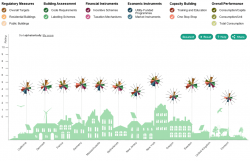The new Policy Tool for Renovation released by the Global Buildings Performance Network (GBPN) compares and analyzes 12 best-practice renovation policies for residential buildings from Europe and the United States, using 14 criteria that define a state-of-the-art policy package. This new and detailed analysis of current best-practice renovation policies supports decision-makers to accelerate the design and implementation of more ambitious energy renovation policies.
The six U.S. states that users of the interactive tool can compare are: California, Massachusetts, New Jersey, New York, Oregon, and Vermont. IMT is the U.S. hub of the GBPN.
The recent IPCC report emphasizes the devastating impacts of climate change and calls for urgent action. The building sector must play a central role in mitigating global energy consumption. The GBPN’s research shows that by 2050, it is possible for the building sector to consume 30 percent less energy than it does today, even with the expected growth in population, floor space, and comfort (Buildings For Our Future, GBPN, 2013).
To achieve this, the GBPN proposes a “deep path” for closing the energy and emissions gap in the building sector, requiring a 70 percent reduction in energy consumption in existing buildings. Specifically, in the European Union (EU) and in the United States (U.S.), the largest potential for energy savings lies in the renovation of the residential building stock. Therefore, it is urgent that deep energy efficiency renovation policies and supporting programmes become standard practice.
What key elements must progressive energy renovation policies address to reach to these goals? What can we learn from current best practice policies in the EU and in the U.S.? Are they ambitious enough? To help answer these questions, the GBPN, with the support of a panel of international experts in the field, identified 14 criteria that define the key elements of a state-of-the-art policy package and scored the selected best-practice policy packages against these. The outcome of the research captures the performance of the current best practices, enables their comparison, and provides insight into what needs to be realized to accelerate more and deeper renovation policies.
A number of key findings have emerged from the research:
1. Energy renovation policy is an emerging field and there is scope for further progress. The tool shows elements where positive steps have been taken and where countries and states can learn from these actions.
2. The countries and states that were successful in reducing all consumption indicators were found to have holistic policy packages in place that address all aspects of the renovation process.
3. There is no such thing as an overall “best” policy package, and all countries and states can benefit from best-practice sharing.
4. Financial mechanisms need to be locally adapted and linked to broader national renovation strategies. National incentives and taxation mechanisms are widely used in the European countries, whereas utility-funded and market based mechanisms are used in American states.
5. Among the current best-practice renovation policies, there is a general absence of clear and ambitious targets for the renovation of the existing building stock.
The online Policy Tool allows interactive visualisation of the scoring of the 12 best practice policy packages under each criterion. The tool also provides detailed information about each jurisdiction and allows to generate graphs based on time series data normalised of energy performance indicators in the respective countries/regions.

